#scapa flow
Explore tagged Tumblr posts
Text


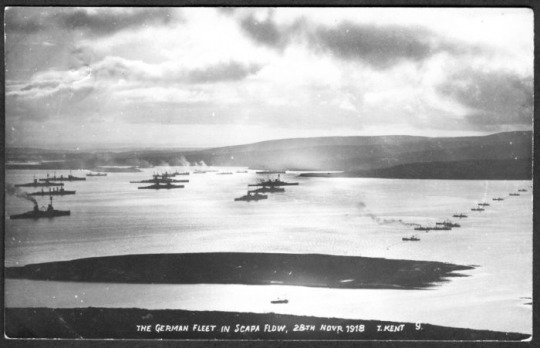
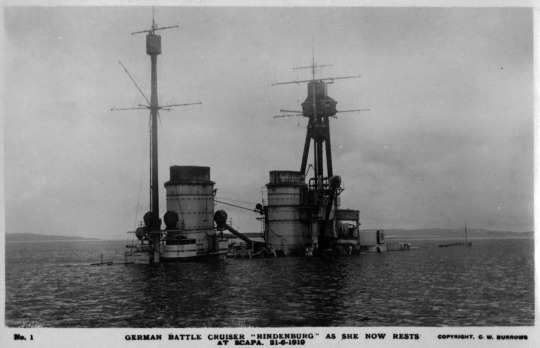



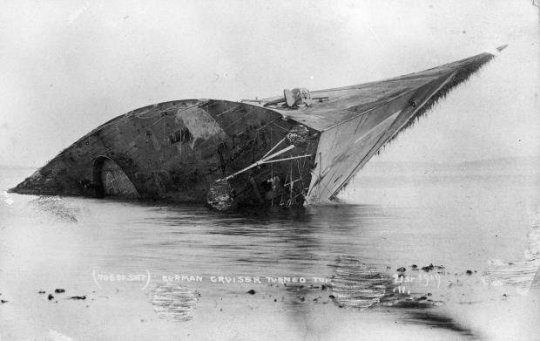




On June 21st 1919, 74 warships of the German fleet were scuttled in Scapa Flow, Orkney.
Learning that the German High Seas Fleet was to be turned over to the Allies, the Germans scuttled their own fleet at Scapa Flow, Scotland, on June 21, 1919. Before the British became aware of what had transpired, the fleet was almost beyond salvage and the German Navy, for all indent, had ceased to exist. As punishment, the Germans had to deliver almost everything left afloat in Germany, including cranes, tugs, and service craft.
The sinking of Germany's captive Imperial Navy off Orkney in 1919 signalled the death of the Kaiser's Reich.
Following the end of World War I in November 1918, 74 German ships were interned in Scapa Flow, a shallow, sheltered bay in the Orkney Islands north of Scotland that had served as one of the Royal Navy's key bases during the war.
The story of their scuttling, which inspired plays and films in the 1920s, was dramatic enough: Skeleton crews, disaffected and sick after months on board, had surreptitiously loosened portholes, drilled holes in bulkheads and left watertight doors open, waiting on the order from their commander, Admiral Ludwig von Reuter, aboard the fleet's flagship, the Emden.
Von Reuter, in turn, was waiting for the outcome of the peace talks in Paris, where the fate of Germany's ships was to be decided. Historians believe that von Reuter had been ordered to sink the ships at all costs (a violation of the Armistice agreement), but only if, as was expected, the Allies decided that they were to be seized. France, in particular, was said to be keen to acquire extra ships.
The British Navy suspected that the Germans were planning to sink the ships and prepared plans to stop them, but von Reuter found an opportunity in an alignment of circumstances: a delay to the signing of the Treaty of Versailles, which the German admiral was not kept informed of, and a bright day on June 21 that allowed the Royal Navy to leave the bay to go out on exercises.
After von Reuter sent out a signal by semaphore and searchlights at around 11:20 a.m., sea cocks, flood valves and internal pipes were opened. It took an hour for the news to reach Admiral Sydney Fremantle of the Royal Navy, leading the exercises, and another two for his fleet to return to Scapa Flow, by which time crews were only able to save 22 of the ships.
During the scuttling, some of the Germans were shot for refusing to go back to their ships to stop them from sinking, And 21 were wounded, mostly from bayonet wounds and being hit with rifle butts.
Thirteen World War I German sailors are now buried in a cemetery on the Orkney Islands: Nine were shot, and the others died during their internment — most probably victims of the flu.
The conditions during the internment were poor. Twenty-thousand Germans were initially brought to Scapa with the ships, though that was gradually reduced to about 1,800 by the time of the scuttling. The British were very strict, and tried everything to avoid allowing the sailors to get into contact with the local population here Life was pretty harsh, especially in autumn and winter. The weather here is pretty rough.
They weren't allowed off the ships. Their supplies had to come from Germany. We wouldn't give them anything. So it would have been pretty grim for them.
That segregation was partly motivated by fears of a spreading flu epidemic on board — but the British may also have had another "contamination" in mind: the spread of communism across Europe. The previous year's revolution in Germany had been started by mutinous sailors, and the vestiges of the class resentment were still on board.
There was still a lot of tensions between the officers and the rank and file, Many of the red sailors made clear that they were revolutionaries, and they to some extent even showed they despised their officers — by stamping on the decks to make it impossible for von Reuter to sleep. He eventually had to change his flagship because he got no sleep.
Nowadays, the last remains of all this drama (many of the ships were later raised) lie 30 meters below the surface. Scapa Flow has become a popular diving spot, where amateur divers regularly come to take a closer at the Kaiser's old ships.
More info and photos on the Scottsih Shipwrechs web page here https://www.scottishshipwrecks.com/the-german-high-seas-fleet/
15 notes
·
View notes
Text

SHOW ALERT: Scapa Flow [Final Show], Tiger Jett, and Wild Step @ Trapper’s Cabin - Friday, June 27th, 2025. Show at 10:00 PM.
#Scapa Flow#Wild Step#Tiger Jett#heavy metal#metal#hard rock#rock#stoner rock#stoner metal#doom metal#Trapper’s Cabin#Newfoundland and Labrador#Happy Valley Goose Bay#Labrador#NL#NFLD#Heavy NFLD#YYT#709#Canada#Canadian metal#Canadian rock#Labradorian rock#Labradorian metal
0 notes
Text
Tenggelam demi Kehormatan: Kisah Armada Jerman di Scapa Flow
KIRKWALL | Priangan.com – Di utara Skotlandia, tersembunyi perairan sunyi bernama Scapa Flow, tempat puluhan kapal perang Jerman berlabuh pasca-Perang Dunia I, bukan sebagai pemenang, tapi juga belum benar-benar kalah. Di sanalah, tanpa pertempuran, tanpa ledakan, sejarah mencatat penenggelaman armada terbesar yang pernah terjadi. Bukan karena diserang, melainkan karena keputusan yang lahir dari…
#Kapal Perang Jerman#Pelabuhan Kapal Perang#Perairan Skotlandia#Perang Dunia I#Scapa Flow#Sejarah Perang
0 notes
Text

Today's Flickr photo with the most hits: Lyness, Hoy, Orkney.
Lyness was the site of an immense naval base in WWI and WWII.
Now, there remain a scattering of abandoned buildings, a war cemetery & a small naval museum.
1 note
·
View note
Text
youtube
Drop Nineteens - Scapa Flow
#drop nineteens#scapa flow#greg ackell#paula kelley#motohiro yasue#steve zimmerman#peter koeplin#jangle pop#dream pop#shoegaze#noise pop#hard light#2023#Youtube
1 note
·
View note
Text
Ghost fishing gear – meaning abandoned, lost or discarded nets, pots or lines – is particularly problematic because it continues to catch marine life. Crabs, rays, fish and even birds or larger mammals such as seals and dolphins get trapped in the gear, where they inevitably die and become bait for more marine life. And so the cycle continues.
According to a 2016 United Nations report, each fishing vessel is likely to lose 1% of its fishing gear per year. More staggering still is the stat that for in every square kilometre of fishing ground there are likely to be 4.4km of ghost nets.
Ghost Fishing UK was set up in 2015 by Dr Richard Walker, a scientist and technical dive instructor. Walker was inspired by his time joining Dutch divers from the now defunct Ghost Fishing Foundation, to clean up ghost nets in the North Sea, in Croatia and from first world war wrecks in Scapa Flow, Orkney.
--
It currently has more volunteers than vacancies. [Ghost Fishing UK] estimates there are 300 on the waiting list, drawn to the charity through word of mouth among the dive community. The selection process is rigorous, with technical dive skills prioritised. Divers tend to self-fund their trips, though the organisation also receives support from private donations and from conservation organisations including the Sussex Wildlife Trust, World Animal Protection and the Sea LifeTrust. People can help by donating to support the charity’s work, and by reporting ghost gear via a form on its website.
--
Tom Collinson is senior advocacy manager at Blue Ventures, a charity that seeks to restore the world’s oceans and improve the livelihoods of fishing communities. He is enthusiastically supportive of the work done by Ghost Fishing UK and other likeminded organisations, such as the Scottish Creel Fishermen’s Federation and the Global Ghost Gear Initiative. “Ghost fishing gear presents a unique and complex challenge and if it weren’t for these dedicated groups, our reefs and wrecks would be festering under blankets of nylon and dead marine life,” he says.
But he also cautions that benefits these groups bring are tiny relative to “industrial destructive fishing practices and particularly bottom trawling”. Critics liken the latter to using a bulldozer and then a vacuum cleaner on the ocean floor.
#ghost fishing#good news#environmentalism#science#environment#united kingdom#marine life#ocean life#nature#animals#scuba diving#ghost fishing gear#fishing nets#abandoned fishing nets#industrial fishing#fishing industry#bottom trawling#sea#sea life
234 notes
·
View notes
Text
NJ's launch and the aforementioned docking after her first underway period has a few stories like that. For instance:
Upon being launched with 100,000 pounds of grease and too few slewing cables, she decided to reach across the Delaware and give her namesake state a little kiss with her bow.
the aforementioned little kiss caused her to get stuck in the drydock where she had her turrets installed due to one of the wooden riders getting stuck in her hull.
The conning tower welds cracked in the Philadelphia winter, so a wood and tar paper house was built over it to protect it from the elements while it was rewelded. you'll never guess what happened to the wood and tar paper house during rewelding.
the shed built over her conning tower caught fire again after she got back from her first time underway.
During her mighty swing to destroy that outhouse that looked at her funny, various crap got sucked into the main condenser (which caused her main engines to fail. not only that, she couldn't steer because her rudders were stuck in mud and her backup engines overheated because water wasn't getting to them). The crap included a four-foot shark, a snake, and hundreds of condoms.
Incredible that a ship plagued by a comedy of errors would later become the most decorated battleship in the US Navy (and change a little geography, as a treat). Makes me think of Enterprise, which had an unfortunate pre-war career iirc.
Also, I didn't even consider that they'd have to make up for the difference in weight between two turrets and stuff for seaplanes before.
Considering the amount of military obsessed trans girls I've met I wonder how these inevitably domesticated sophonts would manage to explain to their owners that they need detailed WW2 battle reports for their latest overnet video breakdown of some obscure battle between the USS *insert state* and the DKM unbekannt
#still fuming about operation crossroads too#we could have had so many awesome museum ships#and we nuked them instead#<- prev#FOR REAL THO#I'm fuming about a lot of ships not becoming museum ships#Enterprise should've been one#Prinz Eugen should've been one#Warspite should've been one#as impractical as it would've been it would've been really cool if Seydlitz was raised from Scapa Flow and turned into one#i need more big ships with big guns to activate my neurons more
94 notes
·
View notes
Text

TBF Avengers in formation over the carrier USS Ranger with destroyer USS Forrest trailing while training in the Atlantic off Scapa Flow, Scotland, United Kingdom, 4 Sep 1943.
@Hiddenhistory via X
84 notes
·
View notes
Text

© The rights holder (Q 74287) A group of Naval Officers at Scapa Flow.
27 notes
·
View notes
Text
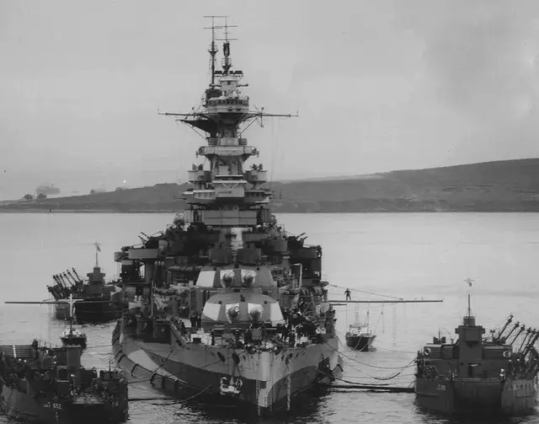
The battleship HMS Malaya entering drydock at Scapa Flow, 1943. This view gives a good view of how the foredeck is cut away to give the 6-inch battery firing angles forward.
26 notes
·
View notes
Text
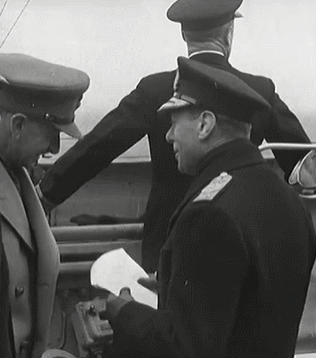
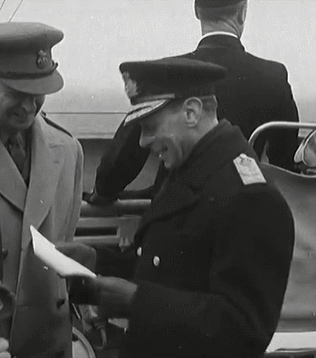
SCAPA FLOW, MARCH 1943: KING GEORGE VI shares a laugh with senior officers during a visit to the Home Fleet. // British Pathé
36 notes
·
View notes
Text


June 5th 1916 saw the loss of HMS Hampshire off Marwick Head, Orkney, with the loss of over 700 lives, including Lord Kitchener. Only 12 survived.
The Hampshire was en route from Orkney to Russia, taking Lord Kitchener on a secret mission to bolster support from the Tsar for the war when it hit a mine and sank. It wasn’t until lately that a definitive number was put on the number of deaths, a final figure of 737 souls were lost at sea that day.
Two of the most persistent rumours examined in a recent book, were that the ship sailed through a known minefield and that the military refused to allow local Orcadians to help with rescue attempts. Their conclusions are that the first was down to a simple misprint in an official document and the second did not hold up to close scrutiny, except in just two isolated cases.
Accusations of incompetence or collusion against the Admiralty have focused on the destruction of another ship, HM Drifter Laurel Crown, on 2 June, blown up by the same minefield laid by submarine U-75, and why the Hampshire was sent through a known danger zone. It has since been said that the Laurel Crown was actually blown up on June 22nd, but to me this still begs the question, why it was allowed to go through this minefield after the Hampshire sinking? Some answers we will never know.
The wreck is designated as a controlled site under the Protection of Military Remains Act and diving is forbidden without a licence.The ship is upside down at a depth of 55–70 metres of water. In 1983 one propeller and part of its drive shaft were salvaged. They are now on view at the Scapa Flow Visitor Centre and Museum, Lyness, Hoy, Orkney.
The Kitchener Memorial at Marwick Head, five miles east of Dounby in Orkney, stands to commemorate, not just him, but all those who lost their lives that day.
9 notes
·
View notes
Text

SHOW ALERT: Scapa Flow @ Trapper’s Cabin - Friday, January 24th, 2025. Show at 10:00 PM.
#Scapa Flow#hard rock#rock#heavy metal#metal#Trapper’s Cabin#live music#Happy Valley Goose Bay#Labrador#Newfoundland and Labrador#NL#NFLD#Heavy NFLD#YYT#709#Canada#Canadian rock#Canadian metal#Labradorian rock#Labradorian metal
0 notes
Text
Spray-Painted Spiders (A PunkFlower ficlet)
A/N: In my day job, I work not far from the Leake Street tunnel, a tunnel in London's Southbank totally covered in amazing graffiti. One day, I was walking through and couldn't help but imagine how Miles might react to the place, and this little fic started to write itself in my head...
Originally I was going to have Gwen and Pav join them, but I decided to keep it simple, just Miles and Hobie, and then it turned PunkFlower-ish ;) How to impress your artistic, graffiti-loving crush, by Hobie Brown: bring him to the Leake Street tunnel :D
Pics of the real tunnel after the fic!
---
Miles' whistle echoed around the walls of the tunnel, every inch of them covered in colourfully-painted portraits and landscapes and swirling abstract patterns.
"So people paint... this whole tunnel?" he asked, gaping at their surroundings. "Don't the cops stop them?"
Hobie shrugged fluidly. The two of them were in casual clothing, spider suits tucked away underneath, and the dim light illuminated the smirk on Hobie's face. "They try," he said. "But we're persistent. Besides, they don't like to come down here too much. It's considered an "unsavoury" area."
Miles was busy leaning back to marvel at the ceiling, which was covered in an intricate black and white design. "Woah, how did they get up there?"
The longer his eyes travelled over it, the more the geometric design started to resemble something... familiar. Something like a series of spiralling, interlocking spider webs. "Did you...?"
Hobie's smirk was decidedly wolfish now. Miles was glad that the dark concealed his pink cheeks. "It could use some flair, I think," he said. He unslung the backpack on his shoulder and took out a can of red spray paint, which he presented to Miles with a flourish. "You up for it?"
Miles reached out to accept the spray can, and their fingers brushed. He answered Hobie's grin with his own. "Yeah, man."
Under cover of darkness, masks pulled down to cover their faces, the two Spiders leapt lightly up the walls and clung to the ceiling. Miles stared at the black and white canvas that stretched out below him. It wasn't often that he built on someone else's work, but this design... Colour leapt into his mind's eye, weaving in and out of the spaces between the webs. He could see it so easily. Mesmerised, and not even aware of Hobie watching him, Miles shook the paint can and got to work.
Hours later, the faint glow of sunrise was creeping into the mouth of the tunnel as Miles and Hobie beheld their completed masterpiece. The webs seemed to glow, highlighted with bright shades of neon green and yellow, while in and around the strands crawled spiders in vivid blue and red. Down the walls, spiders crawled and hid in the crevices of the other artists' work, even scuttling across the floor.
Miles eyed his last strokes critically, adding some pale blue highlights to a hanging spider. It was Hobie's turn to give a low whistle, and Miles looked over to see him nodding slowly in approval.
"It looks good. It looks really good."
Miles thrilled inside, even as he tried his best to play it cool. "Not bad, right?"
He could no longer see Hobie's face beneath the mask, but there was a smile in the older Spider's voice as he answered, "Not bad at all."
Miles took a breath to say something more - and then a shout cut through the air.
"HEY!"
The two half-turned, muscles coiled to spring at the first sign of danger. A police officer stood at the entrance to the tunnel, mouth hanging open. "What the hell..."
Hobie reached out a hand, and Miles took it without a second thought. "Let's Scapa Flow," he said in an undertone, and though Miles had no idea what that meant, he got the message. He squeezed back, and Hobie pulled him along as they sprinted into the dark of the tunnel.
Footsteps sounded and a whistle blew, but the officer was no match for the two Spiders. As soon as they got far enough into the tunnel that they'd be hidden from view, Hobie fired a web and leapt into the air, and Miles followed him. Soon, they were out and swinging through the silvery grey London dawn.
There was no-one around to notice the two figures that alighted on top of the stationary Ferris wheel overlooking the river. Miles was panting a tiny bit from the sudden chase, and with a glance at Hobie, he raised his mask. Hobie followed suit a second later.
"So, d'you like it, then?" Hobie asked.
"Like it? It's amazing. Your world is amazing," Miles couldn't help but enthuse. Playing it cool had kind of gone out the window, but he was too suffused with adrenaline and the thrill of the moment to care. He saw Hobie smile, genuinely pleased.
"You know you can come here any time," Hobie said.
"You mean... like Gwen comes here any time?" Miles couldn't help cautiously checking. Hobie glanced over and raised an eyebrow.
"Maybe a bit different to that," he said. Miles looked at Hobie's profile, wondering if it was the pink glow of sunrise touching his face or something else. He thought he knew what Hobie meant, but he wasn't sure how to be sure. Looking back across the water, Miles was searching for the right words when he felt soft lips press against his cheek.
He turned, surprised, and Hobie drew back a tiny bit, but still so close, his dark eyes searching Miles' features. "Too much?" he checked.
Miles smiled, knowing that he didn't need to find the right words after all. "Just right," he said, and leaned in to kiss Hobie on the mouth.
---
A/N: Scapa Flow = go (Cockney Rhyming slang)
In the real Leake Street tunnel, graffiti is actually legal, and it's quite a tourist hotspot, but since this is Hobie's world I decided to make it a more underground, subversive spot. But I kept the London Eye so that they could have a romantic moment afterwards on top of the Ferris wheel ;)
The tunnel really does have artwork on the ceiling - probably not painted by Spider-people, but who knows :D Here are some photos from my recent visit (the artwork changes every time):


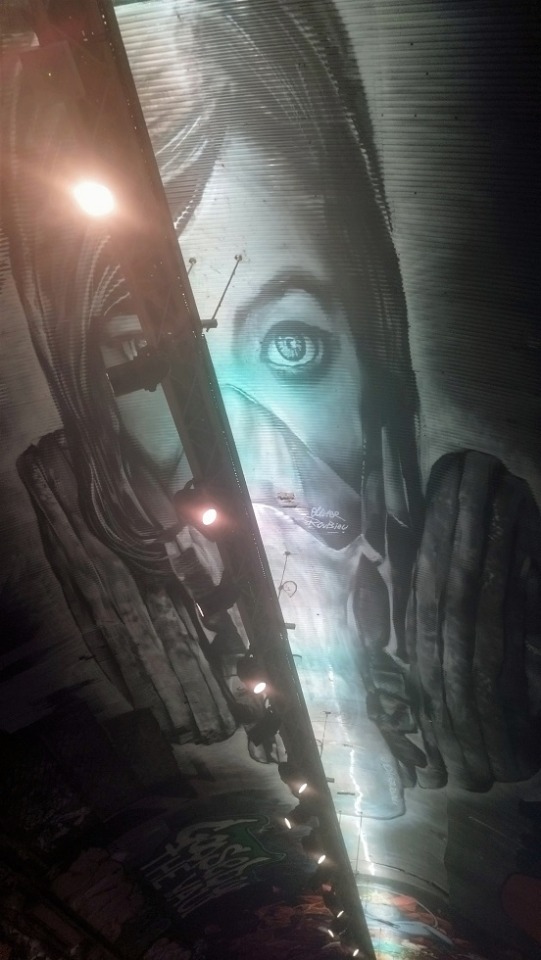
#ficlet#fic#Across the Spiderverse#Spiderman atsv#atsv fic#Across the Spiderverse fic#PunkFlower#FlowerPunk#Hobie x Miles#Miles x Hobie#Hobie Brown#Miles Morales#Spider Punk#graffiti#street art#Leake Street#Leake Street tunnel#does this count as bring your fandom to work
94 notes
·
View notes
Text

SMS Hindenburg arriving at Scapa Flow to be interned, Nov. 21, 1918
24 notes
·
View notes
Note
just because i think this is a fun question, 🔪 ⇢ what's the weirdest topic you researched for a writing project? — @shoshiwrites
Possibly weird (but not weird to me) topics I have researched for writing projects:
price of beer in Britain in 1943
Anglo-Saxon property laws
Romanichal language
daily life in Jellicoe's navy at Scapa Flow
dinner menus for an Irish Country house circa 1920
roman food culture
google street view of a cathedral
[writers truth or dare askbox meme!]
7 notes
·
View notes